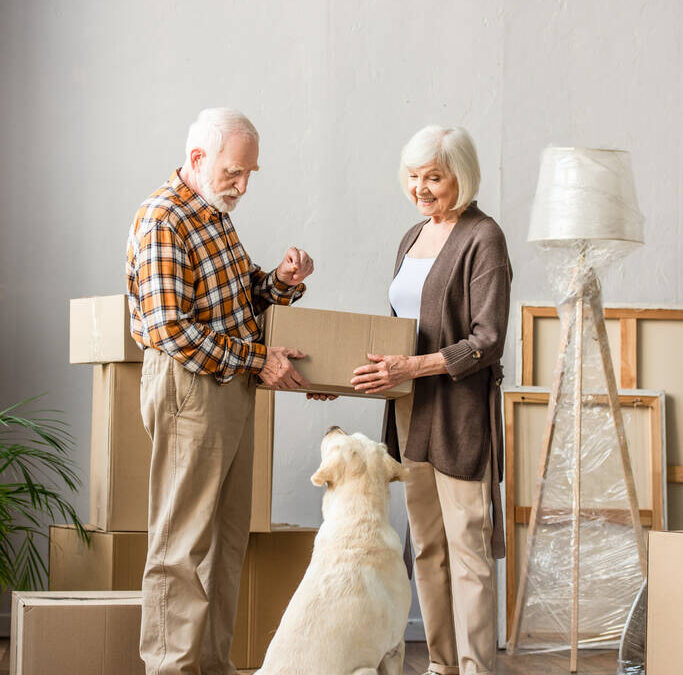To move house and pets safely, update your pet’s ID tags and microchip initially, then check local pet regulations at your new address. Keep their routine steady and confine them to a quiet room during packing to reduce anxiety. For travel, use properly labeled carriers and secure identification. Once you arrive, set up familiar bedding and limit your pet to one room at the outset, gradually expanding their space. Following these steps guarantees you’re set for a smooth shift—discover more detailed strategies ahead.
Key Takeaways
- Update your pet’s ID tags and microchip with your new address before moving.
- Confine pets to a quiet, familiar room during packing and loading to minimize stress.
- Use sturdy, labeled carriers for safe and secure transportation of your pets.
- Unpack your pet’s familiar items first and gradually introduce them to the new environment.
- Maintain consistent feeding, walking, and play routines to help pets adjust after the move.
Pre-Move Planning for Pet Safety
Next, update ID tags and microchip details with your new address, and check local licensing requirements.
Research breed restrictions and pet-friendly zones in your new area.
Gather comfort items like familiar toys and blankets, and pack a supply of any prescription medications.
Ensuring Pet Security During Packing and Loading
Once you’ve set up a solid plan for your pets before moving day, it’s time to focus on keeping them safe as packing ramps up.
Effective packing strategies start with early preparation—introduce moving boxes well in advance so your pets can get used to them. Confine pets to a familiar, quiet room away from the chaos to lower stress, and maintain their usual routines for feeding and play.
Prioritize pet supervision by limiting their access to high-traffic areas.
“Always keep pets in a secure room or crate during packing to prevent accidental escapes or injuries,” advises Dr. Helen Brooks, DVM. Clear pathways, secure loose cords, and keep toxic materials out of reach.
Ultimately, pack vital pet items last for easy access when you need them.
Safe Travel and Transportation Tips for Pets
| Pet’s Need | What You Should Do | Why It Matters |
|---|---|---|
| Comfort | Use proper-sized, labeled carriers | Prevents injuries |
| Safety | Avoid cargo for snub-nosed breeds | Reduces health risks |
| Hydration | Offer water in collapsible bowls | Avoids dehydration |
| Identification | Double-check all tags and microchips | Quick recovery |
Plan ahead, check weather, and confirm travel rules for a smooth trip.
Helping Pets Settle Into Their New Home
Arriving at your new home, your focus shifts from travel logistics to helping your pets feel comfortable and secure in unfamiliar surroundings.
Start by unpacking familiar items such as their bed, toys, and food bowls, placing them in locations similar to those in your previous home. According to Dr. Rachel Evans, “Familiar items help pets recognize their safe space, reducing anxiety during changes.”
Limit your pet’s access to one quiet room initially, allowing gradual exposure to the rest of the home as they grow confident.
Support adjustment with a consistent schedule—feeding, walks, and playtime should remain unchanged.
Supervise exploration and reward calm behavior with treats. Spend extra time alongside your pet, using gentle encouragement and patience to help them settle effectively.
Ongoing Care and Adjustment After the Move
Although you’ve made it through moving day, your pet’s adjustment doesn’t stop there—ongoing care is vital for their well-being in a new environment.
Schedule a post move wellness exam with a local veterinarian as soon as possible, since wait times may be long. Update your pet’s identification tags and microchip details right away; don’t forget to register with new groomers, daycares, or boarding facilities.
Keep routines steady—feed, walk, and play at the same times daily. Arrange familiar bedding and toys to create comfort zones.
Behavioral monitoring is important: watch for anxiety or unusual habits and consult your vet if issues arise. “Consistency and observation reduce stress during changes,” says Dr. Kim Rivera, DVM.
Supervise pets closely, gradually expanding their freedom as they settle in.
Conclusion
By following organized steps, you’ll guarantee your pets’ safety during every stage of your move. Use secure carriers, keep familiar items close, and monitor their behavior. “Consistency and patience help pets adjust,” says Dr. Smith, DVM. Remember: update ID tags, provide fresh water, and create a calm environment. With careful planning and attention, you can minimize stress and help your pets settle into their new home quickly and comfortably.
